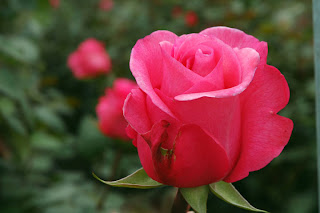I will keep this as brief as possible, but as a quick background sketch it is important to distinguish the different types of flowers that we use in the floral industry in order to highlight the importance and the risks involved in "pinching" roses.
Crops derived from seeds, which are generally annuals (need to be resown every year) and in some cases perennials (after plant is established it will flourish for several years) can be be planned and timed as to exactly when they will produce flowers. So if you want red zinnias for Christmas the grower knows when he will get the harvest, and plants the seeds accordingly. Similarly with bulb crops, the cycle from planting the bulb to harvesting the flowers is pretty much predetermined. The economics are fairly straightforward.
However, shrubs and bushes such as roses produce flowers on mature plants, but these plants need to be established permanently in order to have year round production. Some shrubs like peonies and lilac will only yield one crop per year, while others such as hydrangeas will flower freely for most of the year until it becomes too cold for the plant. Rose shrubs originally only yielded one flush per year but through human intervention and breeding the modern rose now blooms repeatedly throughout the year, as long as they do not endure a prolonged freeze.
Commercial roses plants will produce roughly one flower per plant per month. Some roses, such as "Vendela" have almost double that output while a rose such as David Austin's "Patience" is about a third of the average. As a general rule of thumb the more expensive that a rose is, then the less productive the variety; and vice versa.
However, if an increase in productivity is desired such as for the Valentine's holiday then the grower needs to make an economic decision: Should the production of three months worth of flowers be sacrificed in order to have peak harvest during a one to two week period. On the face of it, you might say that the answer is obvious given the high returns on roses during Valentine's, but it is really a huge gamble with upsides and downsides. But in order to get a surge in prodcution, a "peak" as it were, at a given time, the rose bushes need to be "pinched."
The term originally comes from usage in control of plants with softer vascular structures such as chrysanthemums andd tomatoes. New shoots that are not desirable were literally "pinched" between thumb and forefinger , and thus removed from the plant. Through continued use in agriculture and especially horticulture, it has come to mean removal of plant material to acheive a desired effect. In this case it is cutting the rose canes at lower part of the plant to produce a defined flush at desired time. Each rose variety is managed slightly differently so the location of the cut is carefully assessed on a by-variety basis, as well as the decision to pinch the entire plant or just one or two canes. "Freedom" plants may be entirley levelled for Valentine's while yellow varieties may not be pinched at all.
The pinch is made at the desired height just above a leaf axil, where the leaf joins the stem. After some days a tiny tumescent pink bulge will appear in the axil, which will then form a budding eye, and thereafter develop into a red stem. In some 65 to 90 days depending on the variety and the altitude of the farm, a flower will develop ready for harvesting. That's the theory.
As with many aspects of our lives, economics plays a big part in the decison to pinch.
And lately, growers have found that they can get good prices on a year round, which provides less incentive to pinch for Valentine's. And remember, when a grower harvests everything in a short time, it is like another pinch, meaning less yields for another few months, and maybe another peak when there is little demand, eroding the gains made at Valentine's Day.
Also consider that if the weather is not consistent with historical data then the pinched roses will arrive too early if it is hotter than normal, and too late if it is cooler and darker than normal. Either of these scenarios is undesirable and results in an almost wothless harvest, as there is little demand for roses in January, or after the 10th of February (at farm level).
So the lower availability of roses this year is a combination of much less pinching than in years past and really bad weather. And I mean dreadful!
Looking ahead, I foresee a couple of outcomes: Either there will be even less pinching, with prices for roses being much, much higher at Valentine's as a result of the market forces of supply and demand; or florists/wholesalers/importers will need to place orders in September with the growers, secured by some kind of financial instrument for a specific quantity of roses that will be needed for Valentine's Day. I do not think that it is tenable that floriculture sector can continue as it has for the last twenty years. Surely, we all need to make a profit, including the growers. Especially the growers!
Notwithstanding the above, through today all our roses have moved out of Ecuador with no delays at all, and our numbers are matching the Mayesh projections.





Wonderful insights David!
ReplyDeleteThanks David!!
ReplyDelete